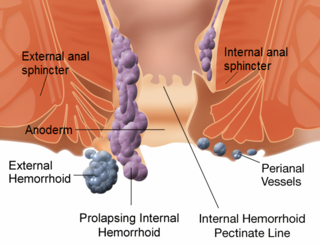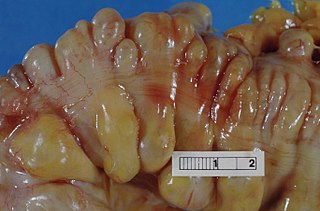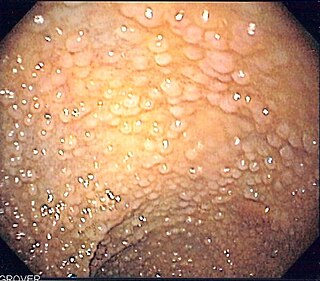Related Research Articles

Ulcerative colitis (UC) is a long-term condition that results in inflammation and ulcers of the colon and rectum. The primary symptoms of active disease are abdominal pain and diarrhea mixed with blood. Weight loss, fever, and anemia may also occur. Often, symptoms come on slowly and can range from mild to severe. Symptoms typically occur intermittently with periods of no symptoms between flares. Complications may include abnormal dilation of the colon (megacolon), inflammation of the eye, joints, or liver, and colon cancer.

Hemorrhoids, also known as piles, are vascular structures in the anal canal. In their normal state, they are cushions that help with stool control. They become a disease when swollen or inflamed; the unqualified term "hemorrhoid" is often used to refer to the disease. The signs and symptoms of hemorrhoids depend on the type present. Internal hemorrhoids often result in painless, bright red rectal bleeding when defecating. External hemorrhoids often result in pain and swelling in the area of the anus. If bleeding occurs it is usually darker. Symptoms frequently get better after a few days. A skin tag may remain after the healing of an external hemorrhoid.

Colorectal cancer (CRC), also known as bowel cancer, colon cancer, or rectal cancer, is the development of cancer from the colon or rectum. Signs and symptoms may include blood in the stool, a change in bowel movements, weight loss, and fatigue.

Rectal prolapse is when the rectal walls have prolapsed to a degree where they protrude out the anus and are visible outside the body. However, most researchers agree that there are 3 to 5 different types of rectal prolapse, depending on if the prolapsed section is visible externally, and if the full or only partial thickness of the rectal wall is involved.

Diverticulitis, specifically colonic diverticulitis, is a gastrointestinal disease characterized by inflammation of abnormal pouches—diverticula—which can develop in the wall of the large intestine. Symptoms typically include lower abdominal pain of sudden onset, but the onset may also occur over a few days. There may also be nausea; and diarrhea or constipation. Fever or blood in the stool suggests a complication. Repeated attacks may occur.

Gardner's syndrome is a subtype of familial adenomatous polyposis (FAP). Gardner syndrome is an autosomal dominant form of polyposis characterized by the presence of multiple polyps in the colon together with tumors outside the colon. The extracolonic tumors may include osteomas of the skull, thyroid cancer, epidermoid cysts, fibromas, as well as the occurrence of desmoid tumors in approximately 15% of affected individuals.

Colorectal surgery is a field in medicine dealing with disorders of the rectum, anus, and colon. The field is also known as proctology, but this term is now used infrequently within medicine and is most often employed to identify practices relating to the anus and rectum in particular. The word proctology is derived from the Greek words πρωκτός proktos, meaning "anus" or "hindparts", and -λογία -logia, meaning "science" or "study".

A colostomy is an opening (stoma) in the large intestine (colon), or the surgical procedure that creates one. The opening is formed by drawing the healthy end of the colon through an incision in the anterior abdominal wall and suturing it into place. This opening, often in conjunction with an attached ostomy system, provides an alternative channel for feces to leave the body. Thus if the natural anus is unavailable for that function, an artificial anus takes over. It may be reversible or irreversible, depending on the circumstances.

Familial adenomatous polyposis (FAP) is an autosomal dominant inherited condition in which numerous adenomatous polyps form mainly in the epithelium of the large intestine. While these polyps start out benign, malignant transformation into colon cancer occurs when they are left untreated. Three variants are known to exist, FAP and attenuated FAP are caused by APC gene defects on chromosome 5 while autosomal recessive FAP is caused by defects in the MUTYH gene on chromosome 1. Of the three, FAP itself is the most severe and most common; although for all three, the resulting colonic polyps and cancers are initially confined to the colon wall. Detection and removal before metastasis outside the colon can greatly reduce and in many cases eliminate the spread of cancer.
An abdominoperineal resection, formally known as abdominoperineal resection of the rectum and abdominoperineal excision of the rectum is a surgery for rectal cancer or anal cancer. It is frequently abbreviated as AP resection, APR and APER.

Ileostomy is a stoma constructed by bringing the end or loop of small intestine out onto the surface of the skin, or the surgical procedure which creates this opening. Intestinal waste passes out of the ileostomy and is collected in an external ostomy system which is placed next to the opening. Ileostomies are usually sited above the groin on the right hand side of the abdomen.
In medicine, the ileal pouch–anal anastomosis (IPAA), also known as an ileo-anal pouch, restorative proctocolectomy, ileal-anal pullthrough, or sometimes referred to as a j-pouch, s-pouch, w-pouch or an internal pouch, is an anastomosis of the ileum to the anus, bypassing the former site of the colon in cases where the colon has been removed. It retains or restores functionality of the anus, with stools passed under voluntary control of the patient, preventing fecal incontinence and serving as an alternative to ileostomy. The pouch component is a surgically constructed intestinal reservoir; usually situated near where the rectum would normally be. It is formed by folding loops of small intestine back on themselves and stitching or stapling them together. The internal walls are then removed thus forming a reservoir. The reservoir is then stitched or stapled into the perineum where the rectum was.
Pouchitis is inflammation of the ileal pouch, an artificial rectum surgically created out of ileal gut tissue in patients who have undergone a colectomy. The ileal pouch-anal anastomosis is created in the management of patients with ulcerative colitis, indeterminate colitis, familial adenomatous polyposis, or rarely, other colitides.
Total mesorectal excision (TME) is a standard surgical technique for treatment of rectal cancer, first described in 1982 by Professor Bill Heald at the UK's Basingstoke District Hospital. It is a precise dissection of the mesorectal envelope comprising rectum containing the tumour together with all the surrounding fatty tissue and the sheet of tissue that contains lymph nodes and blood vessels. Dissection is along the avascular alveolar plane between the presacral and mesorectal fascia, described as holy plane. Dissection along this plane facilitates a straightforward dissection and preserves the sacral vessels and hypogastric nerves and is a sphincter-sparing resection and decreases permanent stoma rates. It is possible to rejoin the two ends of the colon; however, most patients require a temporary ileostomy pouch to bypass the colon, allowing it to heal with less risk of infection, perforation or leakage.

Anal sphincterotomy is a surgical procedure that involves treating mucosal fissures from the anal canal/sphincter. The word is formed from sphincter + otomy.
Polyposis registries exist for the purpose of understanding the genetic disease familial adenomatous polyposis. The registries provide a service to doctors for identification, surveillance and management of families and individuals with high colorectal cancer risk from Familial Adenomatous Polyposis (FAP) and Hereditary Non-Polyposis Colorectal Cancer (HNPCC). The Centers for Disease Control of the United States provides, royalty-free, Registry Plus software for collecting and processing cancer registry data compliant with national standards established by health professionals and regulators to understand and address the burden of cancer more effectively.
In medicine, Blumer's shelf is a finding felt in rectal examination that indicates that a tumor has metastasized to the pouch of Douglas. It is usually a site of metastasis of cancers of the lung, pancreas, and stomach.
Nigro protocol is the preoperative use of chemotherapy with 5-fluorouracil and mitomycin and medical radiation for squamous cell carcinomas of the anal canal. Success of the preoperative regimen changed the paradigm of anal cancer treatment from surgical to non-surgical and was the advent of definitive chemoradiation being accepted as a standard-of-care for anal squamous cell carcinomas. Larger doses of radiation are used in modern chemoradiotherapy protocols versus the original Nigro protocol radiotherapy dose.

Cuffitis is inflammation at the anal transition zone or "cuff" created as a result of ileal pouch-anal anastomosis (IPAA). It is considered a variant form of ulcerative colitis that occurs in the rectal cuff. Cuffitis is a common complication of IPAA, particularly when a stapled anastomosis without mucosectomy procedure has been used.

Steven D. Wexner is an American surgeon and physician. He is Director of the Digestive Disease Center at Cleveland Clinic Florida, where he has worked since 1988. He has received numerous regional, national, and international research awards. Through his multiple academic appointments, Wexner personally trains 15-20 surgeons each year, and he educates thousands more around the world through conferences and lectures. However he also maintains a clinical practice and continuing research. In 2020 he was elected Vice-Chair of the Board of Regents of the American College of Surgeons. He also serves as Symposium Director of the Annual International Colorectal Disease Symposium, held each year in Fort Lauderdale, Florida.
References
- ↑ van der Ploeg, VA; Maeda, Y; Faiz, OD; Hart, AL; Clark, SK (October 2018). "Standardising assessment and documentation of pouchoscopy". Frontline Gastroenterology. 9 (4): 309–314. doi:10.1136/flgastro-2017-100928. PMC 6145428 . PMID 30245794.